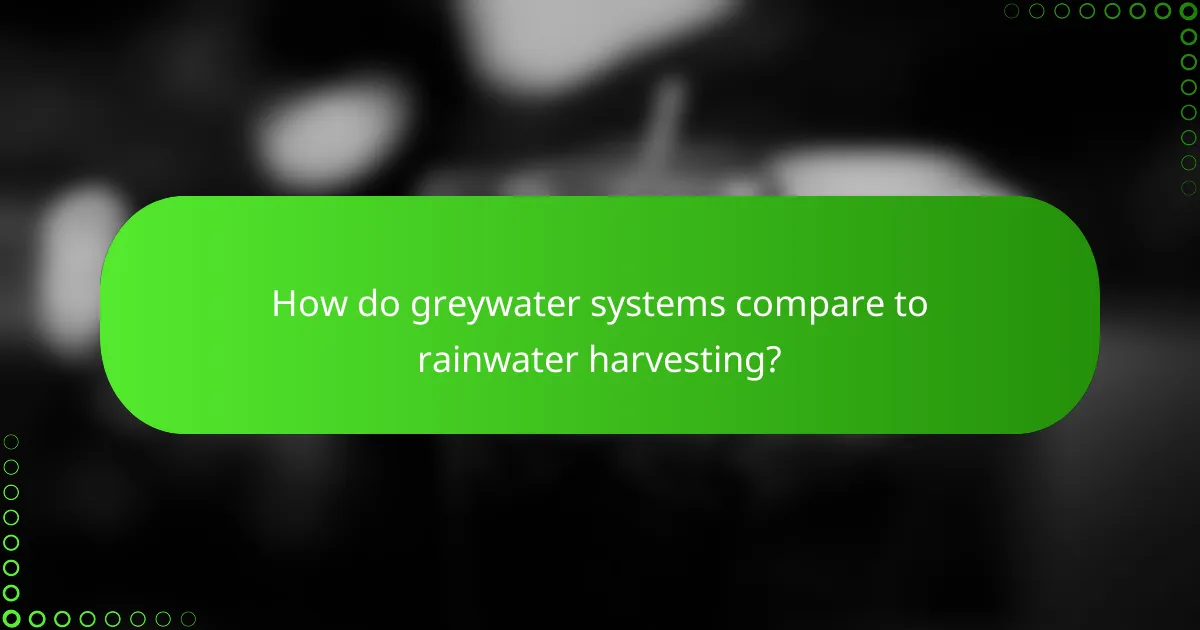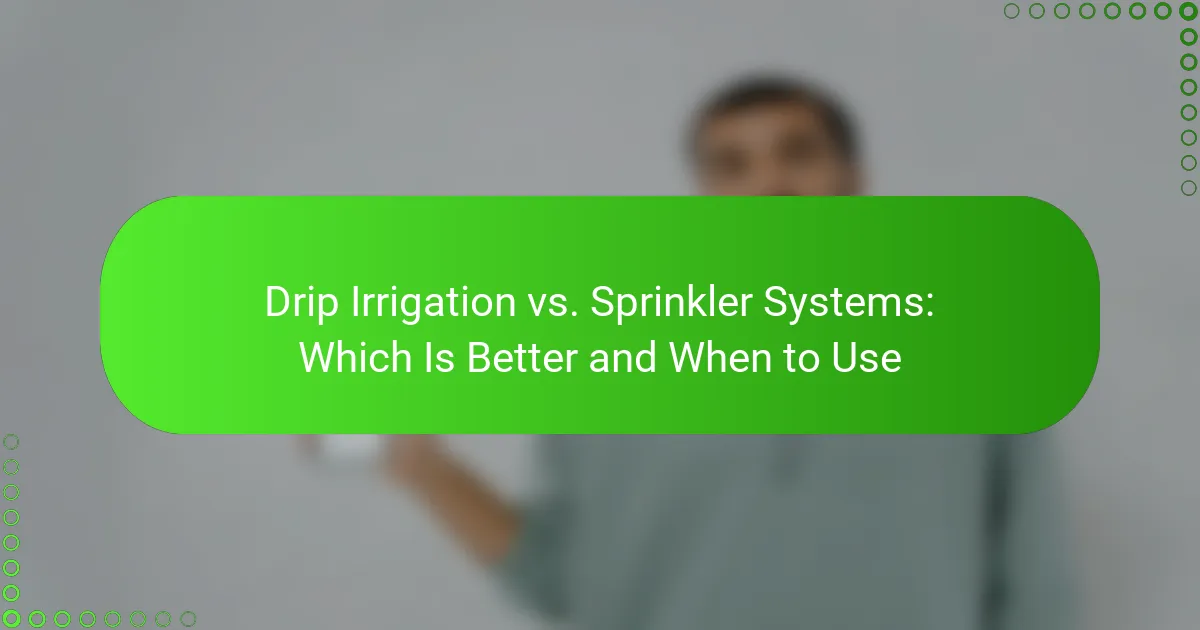Greywater systems present an innovative solution for water conservation by recycling wastewater from sinks, showers, and washing machines for non-potable uses such as irrigation and toilet flushing. Effective design and implementation require careful consideration of system components, local regulations, and maintenance practices to ensure optimal performance and environmental benefits.

What are the benefits of greywater systems in South Africa?
Greywater systems in South Africa offer significant advantages, including enhanced water conservation, reduced utility costs, and positive environmental impacts. These systems recycle water from sources like sinks and showers, making it available for irrigation and other non-potable uses.
Water conservation
Implementing greywater systems is a practical approach to water conservation, especially in regions facing water scarcity. By reusing water from daily activities, households can significantly reduce their overall water consumption, often by 30-50%.
Consider installing a greywater system that captures water from baths, showers, and washing machines. This water can then be redirected to irrigate gardens or flush toilets, helping to preserve precious freshwater resources.
Cost savings
Greywater systems can lead to considerable cost savings on water bills. By reusing water, households can lower their monthly expenses, particularly in areas where water costs are rising due to scarcity.
Investing in a greywater system may require an initial outlay, but the long-term savings often justify the expense. Many homeowners report savings of hundreds to thousands of rand annually, depending on their water usage and local rates.
Environmental impact
Utilizing greywater systems contributes to a healthier environment by reducing the demand on municipal water supplies and decreasing wastewater discharge. This practice helps to alleviate pressure on local water resources and treatment facilities.
Moreover, greywater can be beneficial for gardens, providing nutrients and reducing the need for chemical fertilizers. This natural approach supports sustainable landscaping and promotes biodiversity in urban areas.

How to design a greywater system?
Designing a greywater system involves creating a setup that collects and reuses wastewater from sinks, showers, and washing machines for non-potable applications like irrigation and toilet flushing. Key factors include understanding system components, design considerations, and ensuring compliance with local regulations.
System components
A greywater system typically consists of a collection tank, filtration system, pump, and distribution network. The collection tank gathers greywater, while the filtration system removes debris and contaminants. The pump then moves the treated water to its intended use, such as irrigation or toilet flushing.
Common materials for these components include PVC piping for the distribution network and durable tanks that can withstand varying water levels. Selecting high-quality components can enhance system longevity and efficiency.
Design considerations
When designing a greywater system, consider the volume of greywater generated and the intended reuse applications. Assessing the household’s water usage patterns can help determine the size of the collection tank and the capacity of the filtration system.
Additionally, think about the layout of your property. The system should be designed to facilitate easy access for maintenance and repairs while ensuring that the distribution network reaches all intended areas efficiently.
Regulatory compliance
Compliance with local regulations is crucial when designing a greywater system. Many regions have specific guidelines regarding the treatment and reuse of greywater to ensure public health and environmental safety. Check local building codes and health department regulations before installation.
In some areas, permits may be required, and systems must meet certain standards for filtration and treatment. Familiarizing yourself with these regulations can prevent costly modifications or fines later on.

What are the implementation steps for greywater systems?
Implementing a greywater system involves several key steps to ensure effective design, installation, and maintenance. These steps include site assessment, installation process, and testing and validation to confirm the system’s performance and compliance with local regulations.
Site assessment
The site assessment is crucial for determining the feasibility of a greywater system. This involves evaluating the existing plumbing, soil conditions, and local regulations regarding greywater reuse. Understanding the volume of greywater generated and its intended use—such as irrigation or toilet flushing—will guide the design process.
Consider factors like the proximity of the greywater source to the intended reuse area and any potential environmental impacts. Consulting with local authorities can help clarify any restrictions or requirements that may influence the system’s design.
Installation process
The installation of a greywater system typically involves several stages, including the setup of collection, treatment, and distribution components. Begin by installing a diverter valve to direct greywater from sinks, showers, or washing machines to the treatment system. Ensure that all plumbing connections are secure and compliant with local codes.
Next, install a filtration system to remove debris and contaminants from the greywater. Depending on the intended use, additional treatment methods, such as biological or chemical processes, may be necessary. Finally, connect the distribution system to deliver treated greywater to its intended use area, ensuring proper drainage and flow rates.
Testing and validation
After installation, testing and validation are essential to ensure the greywater system operates efficiently and safely. Conduct initial tests to measure flow rates, pressure, and water quality, ensuring that the system meets local health and safety standards. Regular monitoring should be established to track performance over time.
Validation may also involve obtaining necessary permits or certifications from local authorities. Document all testing results and maintenance activities to maintain compliance and facilitate any future inspections or upgrades. Regular maintenance checks will help identify potential issues early and ensure the longevity of the system.

What are the maintenance requirements for greywater systems?
Greywater systems require regular maintenance to ensure they operate efficiently and safely. Key maintenance tasks include routine inspections, adherence to cleaning protocols, and timely system upgrades to meet evolving standards and technologies.
Regular inspections
Conducting regular inspections is crucial for the longevity of greywater systems. Inspections should occur at least once every six months to check for leaks, clogs, and overall system integrity. During these inspections, look for signs of wear and tear on components such as pumps and filters.
It’s beneficial to keep a maintenance log that records inspection dates, findings, and any actions taken. This documentation can help identify patterns or recurring issues that may need more attention.
Cleaning protocols
Establishing effective cleaning protocols is essential for maintaining greywater systems. Filters should be cleaned or replaced according to the manufacturer’s recommendations, typically every few months, depending on usage. Regularly flushing the system with clean water can help prevent buildup and clogs.
Additionally, ensure that any storage tanks are cleaned at least once a year to prevent algae growth and other contaminants. Following these cleaning protocols will help maintain water quality and system efficiency.
System upgrades
Upgrading components of greywater systems can enhance performance and compliance with current regulations. Consider replacing outdated pumps or filters with more efficient models that consume less energy and improve water quality. Regularly review local regulations to ensure your system meets any new requirements.
Investing in smart technology, such as automated monitoring systems, can also provide real-time data on system performance, alerting you to potential issues before they become significant problems. This proactive approach can save time and money in the long run.

What regulations govern greywater systems in South Africa?
In South Africa, greywater systems are regulated by a combination of national and local laws that ensure safe and sustainable water reuse. These regulations focus on health, safety, and environmental protection, requiring compliance with specific standards for design and implementation.
Local bylaws
Local bylaws in South Africa vary by municipality and often dictate the installation and use of greywater systems. Homeowners must check with their local authorities to understand specific requirements, such as permits, system design, and maintenance protocols. Non-compliance can result in fines or mandatory removal of the system.
Many municipalities have guidelines that specify which types of greywater can be reused, such as water from sinks and showers, while prohibiting the use of water from toilets. Understanding these local bylaws is crucial for legal and effective greywater management.
Health and safety standards
Health and safety standards for greywater systems in South Africa are primarily governed by the National Water Act and the National Health Act. These regulations aim to prevent contamination and protect public health by ensuring that greywater is treated adequately before reuse.
Systems must be designed to minimize health risks, such as using filtration and disinfection methods. Regular maintenance is essential to comply with these standards, including routine inspections and cleaning to prevent blockages and ensure safe operation.

How do greywater systems compare to rainwater harvesting?
Greywater systems and rainwater harvesting serve different purposes in water management. Greywater systems recycle water from household activities, while rainwater harvesting collects precipitation for various uses. Both systems can contribute to water conservation and sustainability but differ in their implementation and resource management.
Resource availability
Greywater systems rely on the consistent production of wastewater from domestic sources like sinks, showers, and laundry. This makes them highly dependent on household water usage patterns. In contrast, rainwater harvesting depends on climatic conditions and seasonal rainfall, which can vary significantly by region.
For instance, in areas with high rainfall, rainwater harvesting can provide a substantial resource, while in drier climates, greywater systems may be more reliable. Homeowners should assess their local climate and water usage to determine which system offers the best resource availability for their needs.
Cost analysis
The initial setup cost for greywater systems can range from a few hundred to several thousand dollars, depending on the complexity of the system and local regulations. Maintenance costs are generally lower, as greywater systems require less frequent upkeep compared to rainwater systems, which may need regular cleaning and filter replacements.
Rainwater harvesting systems can have higher installation costs, particularly if they include large storage tanks and filtration systems. However, the long-term savings on water bills can offset these initial expenses. Homeowners should evaluate both systems’ costs in relation to their specific water needs and local water prices to make an informed decision.

What are the challenges of greywater systems?
Greywater systems face several challenges, including regulatory hurdles, system complexity, and maintenance requirements. These factors can impact the effectiveness and reliability of greywater reuse, making careful planning essential.
Regulatory hurdles
Many regions have strict regulations governing the use of greywater, which can complicate system installation and operation. Homeowners must often navigate local codes that dictate how greywater can be collected, treated, and reused. Understanding these regulations is crucial to ensure compliance and avoid fines.
System complexity
Greywater systems can vary significantly in design and complexity, ranging from simple diversion systems to advanced treatment setups. This variability can make it challenging to select the right system for specific needs and conditions. Homeowners should assess their water usage patterns and available space to determine the most suitable option.
Maintenance requirements
Regular maintenance is essential for greywater systems to function effectively and safely. This includes routine inspections, cleaning filters, and monitoring water quality. Neglecting maintenance can lead to system failures, unpleasant odors, or health risks, so establishing a clear maintenance schedule is vital.










